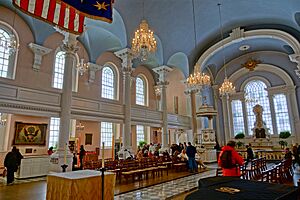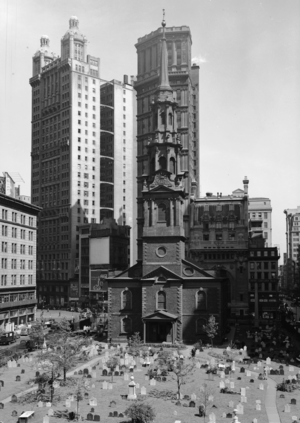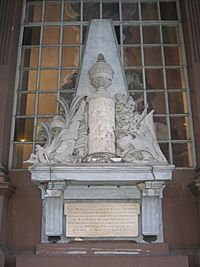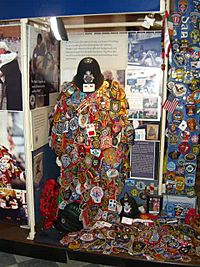St. Paul's Chapel facts for kids
|
St. Paul's Chapel
|
|

St. Paul's Chapel in Manhattan
|
|
| Location | Manhattan, New York City, U.S. |
|---|---|
| Built | 1766 |
| Architect | Thomas McBean or Peter Harrison |
| Architectural style | Georgian |
| NRHP reference No. | 66000551 |
Quick facts for kids Significant dates |
|
| Added to NRHP | October 15, 1966 |
| Designated NHL | October 9, 1960 |
St. Paul's Chapel is a historic church building in Lower Manhattan, New York City. It belongs to Trinity Church, an Episcopal parish. The chapel is located at 209 Broadway, between Fulton Street and Vesey Street.
Built in 1766, it is the oldest church building still standing in Manhattan. It is also a famous example of Late Georgian church design. In 1960, St. Paul's Chapel was named a National Historic Landmark. It was also recognized as a New York City Landmark and added to the National Register of Historic Places in 1966.
After the September 11, 2001, attacks, the chapel stood strong. It survived the collapse of the World Trade Center towers right behind it. Because of this, the chapel earned the nickname "The Little Chapel That Stood".
Contents
Chapel Design and Features
St. Paul's Chapel is part of the Parish of Trinity Church. It was built on land given by Anne, Queen of Great Britain. The main part of the building was constructed between 1764 and 1766. The church's tall spire was added later, from 1794 to 1796.
The chapel is made of Manhattan mica-schist stone with brownstone corner blocks. Its design includes a classic portico (a porch with columns). It also has simple, boxy shapes and home-like details. These features are typical of Georgian churches, like James Gibbs' St Martin-in-the-Fields in London.
The church's spire is octagonal (eight-sided) and rises from a square base. At its very top is a copy of an ancient Greek monument called the Choragic Monument of Lysicrates. Inside, the chapel's main hall has light colors and a flat ceiling. It also features cut glass chandeliers, which look like those found in homes of that time.
Historians used to think Thomas McBean, a Scottish architect, designed the church. However, new information suggests that Peter Harrison might have been the architect. The church's beautiful interior details were created by Andrew Gautier, a skilled craftsman.
When it was finished in 1766, St. Paul's Chapel was the tallest building in New York City. It was built as a "chapel-of-ease" for people who lived far from the main Trinity Church.
On the Broadway side of the chapel, there was a wooden statue of Saint Paul. This statue was carved by an unknown artist and put up in 1790. In 2016, the original statue was moved inside to protect it from weather. A copy now stands in its place outside. Below the east window, there is a monument to Brigadier General Richard Montgomery. He died during the American Revolutionary War at the Battle of Quebec (1775).
The spire holds two bells. The first bell was made in London in 1797. The second bell was added in 1866 to celebrate the chapel's 100th birthday.
A Look Back: Chapel History
Early Days and the American Revolution
During the American Revolutionary War, a group of soldiers called the Hearts of Oak trained in the chapel's yard. Many of these soldiers were students from King's College (now Columbia University). Alexander Hamilton was an officer in this group.
St. Paul's Chapel survived the Great New York City Fire of 1776. This fire burned a large part of New York City, including Trinity Church. The chapel was saved after the British took control of the city following the Battle of Long Island.
George Washington, along with members of the United States Congress, attended church services at St. Paul's Chapel. This was on his Inauguration Day, April 30, 1789. Washington continued to worship at St. Paul's for two years. This was when New York City was the country's capital and Trinity Church was being rebuilt. Above where Washington's special pew used to be, there is an 18th-century painting. It shows the Great Seal of the United States, which was adopted in 1782.
The chapel has several important monuments and memorials. These show its special place in early New York history. One is a monument to Richard Montgomery, a hero from the Battle of Quebec. It was sculpted by Jean-Jacques Caffieri in 1777. Another is a Neo-Baroque sculpture called "Glory." This was designed by Pierre L'Enfant, who also designed Washington, D.C.. The pulpit (where sermons are given) has a crown and six feathers above it. Fourteen original cut glass chandeliers hang in the main area and balconies.
The September 11, 2001, Attacks
The back of St. Paul's Chapel faces Church Street. This is directly across from the east side of the World Trade Center site. After the attacks on September 11, 2001, the chapel became a vital place. It served as a resting spot and refuge for the many recovery workers at the World Trade Center site.
For nine months, hundreds of volunteers worked tirelessly. They served meals, made beds, and offered comfort and prayers. Firefighters, construction workers, police, and others received help. Massage therapists, chiropractors, podiatrists, and musicians also cared for them.
Amazingly, the chapel survived the attacks without even a single broken window. A sycamore tree on the northwest corner of the property helped protect the building. It took the main force of the falling debris. The tree's roots have been preserved in a bronze memorial by sculptor Steve Tobin. The church's organ was damaged by smoke and dirt. However, it has been repaired and is now used again.
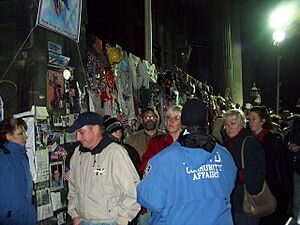
The fence around the chapel grounds became a place for people to leave memorials. It quickly filled with flowers, photos, teddy bears, and other items. Trinity Church officials then put up special panels. Visitors could add their tributes to these panels. They thought only 15 panels would be needed, but they ended up using 400.
Rudy Giuliani gave his farewell speech as mayor at the chapel on December 27, 2001.
Today, the chapel still displays many memorial banners. It also has a detailed audio-video history of the event. There are several exhibits inside. One is "Healing Hearts and Minds," which shows a police uniform covered with patches. These patches were sent from police and firefighters across the U.S. Another notable exhibit is the "Thread Project." It features colorful banners woven from different places around the world. These hang from the upper level over the pews.
Recent Renovations
A major restoration of the chapel's outside began in 2013. The stone blocks and smooth sandstone were cleaned, repaired, or replaced. The steeple clock received a new digital system, and its bells were maintained. Some original clock parts were saved as historical items. The cornices (decorative moldings) were painted with a special sand-infused paint, just like the original. Broken panes in the wooden windows were replaced with crafted glass that looks like antique glass.
At the same time, the churchyard was also restored. The churchyard has always been a peaceful green space in busy lower Manhattan. However, years of damage and a big increase in visitors made it necessary to fix it up. Problems like soil erosion, compacted ground, and overgrown trees were addressed. This sensitive area contains old graves and tree roots. All work was done carefully by hand.
Inside the chapel, renovations included removing the old box pews. This allows the space to be used more flexibly. A new heating and air conditioning system was installed. The interior was repainted in a more authentic off-white color. The old organ was replaced with a 1989 Noack instrument. This new organ was fitted into the historic organ case.
Chapel Services and Famous Visitors
St. Paul's Chapel is still an active part of the Parish of Trinity Church. It holds regular services, weekday concerts, and occasional lectures.
On the evening of September 10, 2006, St. Paul's Chapel hosted a memorial service. President George W. Bush, Senator Hillary Clinton, Governor George Pataki, and mayors Michael Bloomberg and Rudy Giuliani attended. The chapel held more services on the fifth anniversary of the September 11, 2001, attacks.
Many famous people have visited and worshipped at the chapel. George Washington attended services here on his Inauguration Day, April 30, 1789. He continued to worship at St. Paul's for two years while Trinity Church was being rebuilt. Above where Washington's pew once stood, there is a painting of the Great Seal of the United States. This painting was ordered by the church in 1785. The artist is unknown.
Across from the presidential pew was the governor's pew. George Clinton, New York's first governor, used this pew. Its former spot is marked by the arms of the State of New York. Other historical figures who worshipped here include Prince William (who later became William IV of the United Kingdom), Lord Cornwallis, and Sir William Howe. Several U.S. presidents, including Grover Cleveland, Benjamin Harrison, and George H. W. Bush, have also visited.
Burials
Many notable people are buried at St. Paul's Chapel:
- Richard Montgomery and his wife Janet Livingston Montgomery
- Richard Coote, 1st Earl of Bellomont
- William Denning
- John Holt, a publisher
- William Houstoun, a lawyer
- Campbell P. White and his wife Harriet Banyer Le Roy White
- Stephen Rochefontaine
- Elizabeth Downes, first wife of William Franklin
Landmark Status
St. Paul's Chapel was named a National Historic Landmark in 1960. This was partly because it is the oldest public building in New York City that has been used continuously. It was also made a New York City designated landmark in 1966.
In 2016, the New York Landmarks Conservancy gave awards for the chapel and churchyard restoration projects. They received the Lucy G. Moses Preservation Award.
Gallery
-
Monument to Richard Montgomery, above his tomb
See also
 In Spanish: Capilla de San Pablo (Nueva York) para niños
In Spanish: Capilla de San Pablo (Nueva York) para niños
- List of National Historic Landmarks in New York City
- List of New York City Designated Landmarks in Manhattan below 14th Street
- National Register of Historic Places listings in Manhattan below 14th Street
- List of the oldest buildings in New York
- Oldest churches in the United States
- Nearby buildings
- 195 Broadway
- Millennium Hilton New York Downtown


